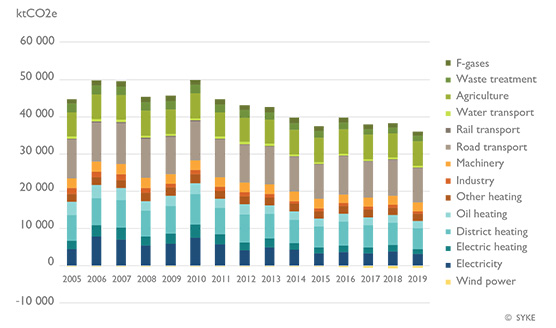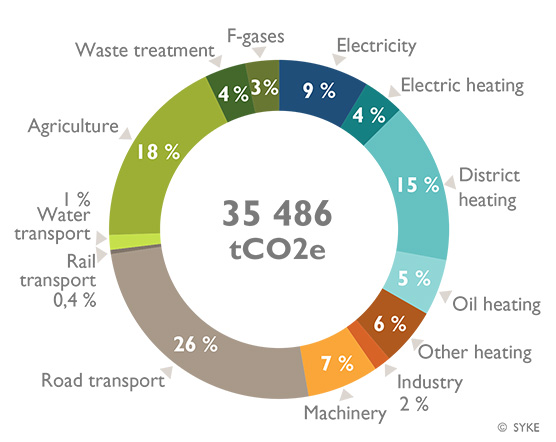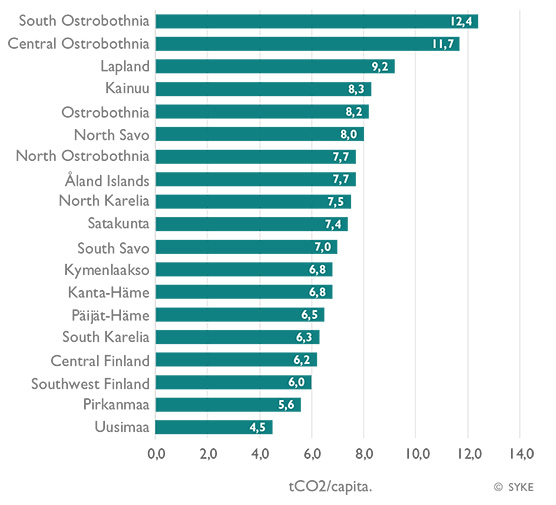Press release 2021-05-31 at 8:47

The total greenhouse gas emissions of Finnish municipalities by sector in 2005–2019 Emissions have been calculated in accordance with the Hinku calculation rules. © SYKE
According to a recent calculation by the Finnish Environment Institute (SYKE), municipal climate emissions decreased by 5.5 per cent in 2019 compared to the previous year. The biggest decrease occurred in the emissions from electricity usage as the emissions from electricity production dropped significantly in Finland. The emissions from district heating, industry and road traffic also decreased, whereas the development of the emissions from machinery, agriculture and water transport was not as positive. However, there are considerable differences between municipalities in the sectoral distribution of emissions and their development.
Over the longer term, emissions have decreased in almost all (96%) Finnish municipalities. The average change over the period from 2005 to 2019 has been -19 %. The factors that have decreased municipal emissions include cleaner electricity production as a result of increased wind power generation, the replacement of oil heating by other methods of heating and the reduced use of fossil fuels and peat in the generation of district heating. In road traffic, the reasons for decreased emissions were the use of bio-components in traffic fuels, an increased number of electric vehicles and a decrease in driving distances.
In 2019, the main sources of emissions in Finnish municipalities were road transport (25%), agriculture (18%), district heating (15%) and electricity consumption (heating and other consumer electricity 13%).
Regional differences in the emissions generated per resident can be explained by regional differences in economic structures, geographical factors, such as long distances, and weather conditions. Compared to the previous year, the emissions per resident either remained the same or decreased in all regions.
“The results of emissions calculation help municipalities and regions monitor their emission targets and plan new emission reduction measures. The emissions trends of 2019 were encouraging, and I hope that this progress will continue in the coming years even after the coronavirus pandemic. There is a great need for ambitious municipal and regional emission reduction measures as Finland needs to achieve its carbon neutrality target and the EU’s tightening emission reduction targets”, says Professor Jyri Seppälä, the National Director of the Hinku network, from the Finnish Environment Institute.
Every year, the Finnish Environment Institute calculates the amount and development of climate emissions for all Finnish municipalities using a standardised calculation method. The results of the ALas calculation model, published in February 2020, have now been updated for 2005–2019.
Distribution of total municipal emissions in 2019

Distribution of total municipal emissions in 2019. Emissions have been calculated in accordance with the Hinku calculation rules. © SYKE
The Hinku calculation supports municipal climate work
SYKE's emissions calculation system ALas covers all Finnish municipalities and 80 emission sectors. Emissions and energy consumption are calculated annually for all municipalities and sectors. The calculation model is updated as necessary; for example, on the basis of new available data.
Hinku calculation rules are applied in the default calculation for monitoring municipal targets. In the Hinku calculation, efforts have been made to exclude factors that the municipalities are unable to influence. Thus, a major part of the industries and transit traffic is excluded from the calculation. Emissions from electricity consumption are calculated based on the average emissions from electricity produced in Finland. Wind power production of the municipal regions is taken into account separately by calculating a carbon credit for wind power production for the municipality.
It is also possible to examine the results of the ALas model without the Hinku calculation filters, without wind power compensation and separately in the Emissions Trading and burden-sharing sectors. Municipal emissions calculations do not include industrial process emissions included in the Finnish greenhouse gas inventory or the land use sector (LULUCF).
In comparison to the previous versions, the ALas 1.2 calculation model released this year only has minor adjustments to improve accuracy. The adjustments were mainly made to municipal wind power generation calculations and district heating emissions calculations in those municipalities that lacked adequate data in the source data. In some sectors, such as agriculture and industry, corrections were made to the source data. The up-to-date method description is available here.
Greenhouse gas emissions per capita in the regions in 2019

Greenhouse gas emissions per capita in the regions in 2019. Emissions have been calculated in accordance with the Hinku calculation rules. © SYKE
More accurate emissions calculation – consumption-based emissions calculation to be introduced in the future
The results of the ALas model have been adopted throughout Finland.
“In the summer of 2021, we will make the calculations more up to date by publishing a flash estimate of the municipal greenhouse gas emissions of 2020. We are continuously striving for more accurate calculations. The goal is to calculate the emissions of the missing sectors by the next annual publication in spring 2022. This year, we have also been automating the calculation process to speed up the publication schedule in the coming years", says Senior Research Scientist Santtu Karhinen from SYKE.
The results of the municipal flash estimate will sum up to the national flash estimate of greenhouse gas emissions by Statistics Finland.
A fully consumption-based emissions accounting method is being developed alongside usage-based accounting, and it will be ready by 2022. Consumption-based accounting is based on the municipality’s household consumption of power, goods and services, as well as investments and public administration consumption. The physical location where emissions are caused plays no role in this case. The entire production chain of goods and services is taken into account in the calculations. Alongside the current calculation system, consumption-based accounting brings another perspective to the regional allocation of emissions and contributes to municipal climate work.
In April 2021, the Finnish Environment Institute published a greenhouse gas emission scenario tool to help municipalities plan their climate roadmaps. In the future, the content of the tool will be expanded to enable more sectors to be analysed in more detail at the level of concrete measures. The next step is to create an agriculture expansion for the tool.
The municipal emissions calculation system has received funding from the Life IP Canemure project of the European Union.
All the results are publicly available:
Graphs
Further information
- Santtu Karhinen, Senior Research Scientist, Finnish Environment Institute, tel. +358 29 525 1889, firstname.lastname@syke.fi
- Juha Grönroos, Senior Research Scientist (Agriculture), Finnish Environment Institute, tel. +358 29 525 1128, firstname.lastname@syke.fi
- Sampo Pihlainen, Senior Research Scientist (Rail and water transport), Finnish Environment Institute, tel. +358 29 525 2225, firstname.lastname@syke.fi
- Tommi Forsberg, Coordinator (F-gases), Finnish Environment Institute, tel. +358 29 525 1116, firstname.lastname@syke.fi
- Jouko Petäjä, Senior Research Scientist (Landfills), Finnish Environment Institute, puh. 029 525 1508, firstname.lastname@syke.fi
- Professor Jyri Seppälä, National Director of the HINKU network, Finnish Environment Institute, tel. +358 29 525 1629, firstname.lastname@syke.fi